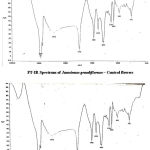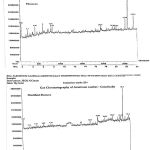S. Elumalai¹, R. Murugesan², N. Chinnasamy¹, M. Prabhakaran¹ and S. Baskaran¹
1PG and Research Department of Plant Biology and Biotechnology, Presidency College, Chennai - 600 005 India.
2Indian Institute of Technology Madras, SAIF (Sophisticated Analytical Instruments Facility), Chennai - 600 036 India.
Abstract
The oils were extracted from the plants and identified, quantified in the differences in both control plants and genetically modified plants of in the experimental plants Jasminum grandiflorum, Jasminum sambac and Polianthus tuberosa. Jasmine essential oil has a sweet and floral aroma, There are well over 100 constitutes found in Jasmine, the main chemical components and health benefits of Jasmine is briefly given in this study. Polianthus tuberosa oil has a slightly spicy, heavy, sweet fragrance. Tuberosa oil is not normally used in aromatherapy but in the perfume industry as a component of good quality perfumes and is said to have narcotic properties. Essential oils were collected and stored in a freezer (4°C) for Perkin Elmer Spectrum One FT-IR and Jeol GC mate II GC-Mass spectrometry studies. Samples and essential oils were analyzed by GC and FT - IR identification of total oil content were carried out on a Agilant coupled with Jeol GC mate – II Mass Spectrometer. Results of the analysis of the essential oil of 3 types of flowers are summarized.
Keywords
J. grandiflorum; J. sambac; P. tuberosa; Genetically Modified flowers; FT-IR, GC-MS
Download this article as:| Copy the following to cite this article: Elumalai S, Murugesan R, Chinnasamy R, Prabhakaran M, Baskaran S. Essential oil Analysis of FT-IR and GC-MS Studies of Jasminum Grandiflorum, Jasminum sambac and Polianthus tuberosa flowers. Biomed Pharmacol J 2010;3(1) |
| Copy the following to cite this URL: Elumalai S, Murugesan R, Chinnasamy R, Prabhakaran M, Baskaran S. Essential oil Analysis of FT-IR and GC-MS Studies of Jasminum Grandiflorum, Jasminum sambac and Polianthus tuberosa flowers. Biomed Pharmacol J 2010;3(1). Available from: http://biomedpharmajournal.org/?p=1152 |
Introduction
Essential oils are the fragrant oils that are present in many plants. Hundreds of plants yield essential oils that are used as perfumes, food flavorings, medicines and as fragrant and antiseptic additives in many common products. Some experts have theorized that essential oils are the lifeblood of a plant, and contain compounds that the plant uses to fight infections and drive away germs and parasites. Scientific research has isolated hundreds of chemicals in essential oils, and has shown many essential oils to have anti-bacterial, anti-fungal, and anti-parasitic properties. Jasmine essential oil is extracted from the flowers of Jasmine, with its scientific names Jasminum grandiflorum and Jasminum sambac. The main chemical components of jasmine are benzoic acid, benzaldehyde, benzyl acetate, benzyl alcohol, indole, benzyl benzoate, cis-3-hexenyl benzoate, cis-jasmone, ceosol, eugenol, farnesol, geraniol, linalool, methyl anthranilate, P-cresol, nerol, gamma terpineol, nerosidol, isohytol and phytol. The health benefits of Jasmine essential oil can be attributed to its properties like anti-bacterial, anti-depressant, anti-inflammatory, anti-septic, anti-spasmodic, anti-spasmodic, anti-viral, aphrodisiac, astringent, calmative, cicatrisant, cooling, emenagogue, expectorant, galactogogue, hypotensive, nervine analgestic, parturient, sedative and uterine. It is a valuable remedy in cases of severe depression and soothes the nerves, producing of feeling of confidence, optimism and euphoria, while revitalizing and restoring energy. The main chemical components of Polianthus tuberosa are menthyl anthranilate benzyl alcohol, butyric acid, eugenol, nerol, farnesol and geraniol. Tuberosa oil is not normally used in aromatherapy but in the perfume industry as a component of good quality perfumes and is said to have narcotic properties. Therefore the present study aims to analysis the essential oil of J. grandiflorum, J. sambac and P. tuberosa flowers by FT – IR and GC – MS.
Table 1: Gas Chromatography of the Jasminum grandiflorum Control Flowers
| S. No | Retention Time | Peak Area | Peak Percentage |
| 1 | 2.2 | 119142064 | 25.53 |
| 2 | 6.95 | 122503064 | 26.25 |
| 3 | 8.75 | 14718008 | 3.15 |
| 4 | 22.78 | 21599280 | 4.62 |
| 5 | 23.25 | 188707296 | 40.43 |
Table 2: Gas Chromatography of the Jasminum grandiflorum Genetically Modified Flowers
| S. No | Retention Time | Peak Area | Peak Percentage |
| 1. | 2.35 | 29060712 | 12.32 |
| 2. | 6.98 | 27387984 | 11.61 |
| 3. | 8.77 | 11956800 | 5.07 |
| 4. | 22.78 | 18729552 | 7.94 |
| 5. | 23.25 | 148689632 | 63.05 |
Materials and Methods
Plant material
For considering the economic importance of the flower oil J. grandiflorum, J. sambac and P. tuberosa were under taken in our study. In our present experiment we have used the Agrobacterium tumefaciens was used for this present study in the above mentioned plants. Induction formations in the experimental plants tumor formation through A. tumefaciens mediated transformation were carried out. The present investigation is the continuation work in our laboratory. Control flower buds and genetically modified flower buds of equal age (8 months) were studied for essential oils analysis.
Table 3: Gas Chromatography of the Jasminum sambac Control Flowers
| S. No | Retention Time | Peak Area | Peak Percentage |
| 1. | 1.85 | 66410992 | 20.79 |
| 2. | 7.51 | 20316264 | 6.36 |
| 3. | 21.76 | 31905384 | 9.99 |
| 4. | 22.23 | 167392312 | 52.42 |
| 5. | 23.33 | 33261160 | 10.41 |
Table 4: Gas Chromatography of the Jasminum sambac Genetically Modified Flower
| S. No | Retention Time | Peak Area | Peak Percentage |
| 1. | 1.91 | 21917520 | 20.82 |
| 2. | 7.54 | 7193296 | 6.83 |
| 3. | 21.78 | 2990712 | 2.84 |
| 4. | 22.2 | 68733208 | 65.30 |
| 5. | 23.33 | 4421744 | 4.20 |
Essential oils analysis of FT-IR and GC-Mass spectrometry
Five gram flower buds were taken along with citric acid. It is grinded with mortar and pestle. Grinding was carrying out for about ½ hour. The pulp mixture was transferred in a beaker. Juice was collected after filtration. Then it is subjected with ether for oil separation. Finally it was stabilized by adding sodium sulphate salts and dried ether by gentle heat (40°C). Essential oils were collected and stored in a freezer (4°C) for Perkin Elmer Spectrum One FT-IR and Jeol GC mate II GC -Mass spectrometry studies. These two experiments were carried in SAIF, IITM, Chennai-36. (Or) The samples were extracted by taking flowers weighed (10gms) and grinded with citric acid finally, essential oils were extracted from the pulp by adding ether and kept the oils at 4°c in a freezer for further analysis. Samples and essential oils were analyzed by GC and FT-IR identification of total oil content were carried out on a Agilant coupled with Jeol GC mate – II Mass Spectrometer. The operating conditions were as follows: Initial column temperature 80°C programmed at a rate of 5°C/min to 280°C: Inlet temperature 250°C. Carrier gas: Helium. Flow rate 30ml/min. Perkin Elemer Spectrum – I, instrument was used to identify chemical constituents of the oils.
Table 5: Gas Chromatography of the Polianthes tuberosa Control Flowers
| S. No | Retention Time | Peak Area | Peak Percentage |
| 1. | 9.87 | 7204024 | 37.67 |
| 2. | 17.00 | 5778584 | 30.22 |
| 3. | 19.23 | 2742640 | 14.34 |
| 4. | 23.18 | 3394888 | 17.74 |
Table 6: Gas Chromatography of the Polianthes tuberosa Genetically Modified Flowers
| S. No | Retention Time | Peak Area | Peak Percentage |
| 1. | 9.9 | 2180760 | 4.86 |
| 2. | 17.00 | 2180760 | 4.86 |
| 3. | 19.23 | 1760800 | 3.92 |
| 4. | 23.18 | 38688640 | 86.33 |
Results and Disscussion
Results of the analysis of the essential oil of 3 types of flowers are summarized in table 1 to 6 and Fig (1 – 6). In the control the difference in essential oil content were lesser in quantity. In the genetically modified flowers these differences were much more significant. In the case of J. grandiflorum both control and GM plants were observed five peaks. In the GM peak number five shows highest peak percentage 63.05 the least is peak number three 5.07. In the case of J. grandiflorum control plant shows the maximum peak percentage 40.43 in peaks number five, the least were recorded 3.15 in the case of peak number three.
 |
Figure 1 |
 |
Figure 2 |
In the second flower J. sambac both control and GM plants GC were recorded five peaks of each. In the case of GM plants the highest peak percentage (65.03) was observed in peak number four. The least peak percentage (2.84) was recorded in the case of peak number three. In control plant the highest peak percentage (52.42) were observe in peak number four, and least peak percentage (6.36) were recorded in the case of peak number two.
 |
Figure 3 |
 |
Figure 4 |
The third flower Polianthus tuberose studies were observed four peaks of each in GM and control plants. In the case of GM plant the highest peak percentage (86.33) were observed in peak number four. The least peak percentage (3.92) were recorded in peak number three. In the case of control plant the highest peak percentage (37.67) in peak number one and the least peak percentage (17.75) were observed in the case of peak number four.
 |
Figure 5 |
 |
Figure 6 |
In our present investigation there are major differences in the essential oil constituents between control and GM plants of all the three experimental plants. J. grandiflorum, J. sambac and P. tuberosa.
Acknowledgement
The authors are thanks to The Principal and Head, Plant Biotechnology Department, Presidency College, Chennai -600 005 and SAIF (Sophisticated Analytical Instruments Facility), IITM, Chennai – 600 036.
References
- Borg-Karlson, A.K., Valterova, I. and Nilsson, L.A., Volatile compounds from flowers of six speices of six species in the family Apiaceae: bouquets for different pollinators? Phytochemistry, 35: 111-119 (1994).
- Caissard, J.C., Joly, C., Bergougnoux., V, Hugueney., P, Mauriat, M. and Baudino, S., Secretion mechanisms of volatile organis compounds in specialized cells of aromatic plants. Res. Devel. Cell Biology, 2: 1-15 (2004).
- Dudai, N., Werker, E., Putievsky, E., Ravid, U., Palevitch, D. and Halevy, A.H., Glandular hairs and essential oils in the leaves and flowers of Majorana syriaca; Israel J. Bot, 37:11- 18 (1988).
- Gershenzon, J. and Croteau, R., Terpenoids. In GA Rosenthal, M Berenbaum, eds, Herbivores: Their Interaction with Secondary Metabolites. Academic Press, New York, pp 165-219 (1991).
- He, C., Liang, Z. and Liu, H., Study on chemical constituents of jasmine absolute extracted by supercritical carbon dioxide. Prod. Res. Dev., 11(3): 53-57 (1998).
- Joulin, d., Cryogenic cacuum trapping of scents from temperate and tropical flowers. In Bioactive Compounds from Plants. ACS Symposium series 525; Teranishi, R, Buttery, G.R, Sugisawa,H; American Chemical Society: Washington, DC, pp 187-204 (1993).
- Knudsen, J.T., Tollsten, L. and Bergstrom, L.G., Floral scents: checklist of volatile compounds isolated by head-space techniques. Phytochemistry, 33: 253-280 (1993).
- Koybayashi, A., Kawamura, M., Yamaamot, Y., Shimizu, K. and Yamanish, T., Methyl epijasmonate in essential oil of tea. Agric Biol. Chem, 52(9): 2299-2303 (1988).
- Morita, K., Kubota, K. and Aishima, T., Sensory characteristics and volatile components in aromas of boiled prawns prepared according to experimental designs. Food Res. Int., 34: 473-4812001.
- Werker, E., Function of Essential Oil- Secreting Glandular Hairs in Aromatic Plants of the Laminaceae. A Review. Flavour and Fragrance Journal, 8: 249-255 (1993).







